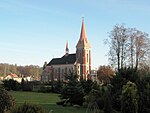Těrlicko Reservoir
Buildings and structures in the Moravian-Silesian RegionCieszyn SilesiaCzech building and structure stubsDams completed in 1962Karviná District ... and 2 more
Moravian-Silesian Region geography stubsReservoirs in the Czech Republic

Těrlicko Reservoir (Czech: vodní nádrž Těrlicko) is a water reservoir and dam in Těrlicko in the Moravian-Silesian Region of the Czech Republic. It was built on the Stonávka River in 1955–1964 on an area of 2.68 km2 (1.03 sq mi).Construction of the dam had major impact on the municipality of Těrlicko. 141 buildings were sunk, including many community buildings and also a church. Těrlicko was eventually transformed into a village with many tourist attractions. Many recreational centres were built. The reservoir is a popular spot for water sports, and is also used to supply water for nearby coal mines and Třinec Iron and Steel Works.
Excerpt from the Wikipedia article Těrlicko Reservoir (License: CC BY-SA 3.0, Authors, Images).Těrlicko Reservoir
U Hotelu, okres Karviná
Geographical coordinates (GPS) Address Nearby Places Show on map
Geographical coordinates (GPS)
| Latitude | Longitude |
|---|---|
| N 49.754722222222 ° | E 18.496111111111 ° |
Address
U Hotelu
U Hotelu
735 42 okres Karviná
Moravia-Silesia, Czechia
Open on Google Maps










